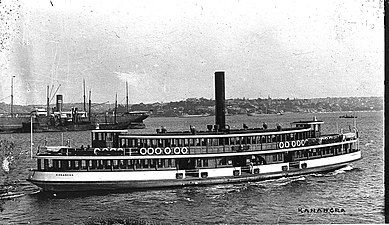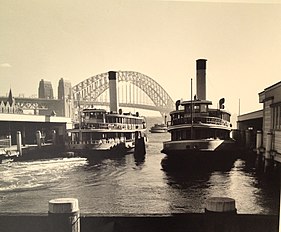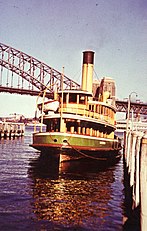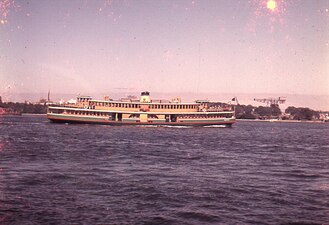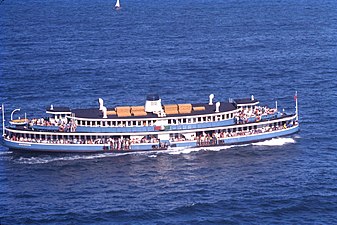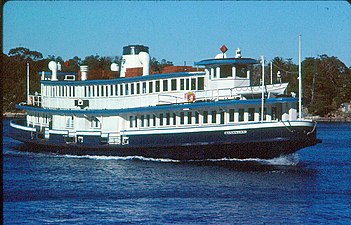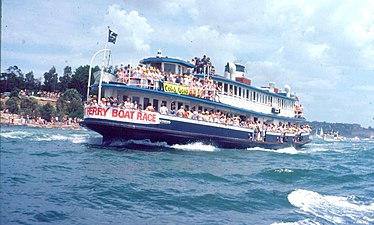Kanangra (ferry)
 Kanangra in Mosman Bay, 1910s
| |
| History | |
|---|---|
| Name | Kanangra |
| Operator | Sydney Ferries Limited Sydney Harbour Transport Board Public Transport Commission Urban Transit Authority |
| Port of registry | Sydney |
| Builder | Mort's Dock |
| Cost | £17,873 |
| Launched | 14 August 1912 |
| Out of service | 1985 |
| Identification | 131544[1] |
| Fate | under restoration |
| General characteristics | |
| Tonnage | 295 tonnes |
| Length | 45.7 m |
| Beam | 9.7 m |
| Decks | 2 |
| Propulsion | as built triple-expansion steam. Crossley diesel (from 1959) |
| Capacity | 945 |
Kanangra is a retired ferry on Sydney Harbour. She was launched in 1912 during the early-twentieth century pre-Sydney Harbour Bridge boom years of Sydney Ferries Limited.
She and her close "sister" ferry,
Kanangra was retired as a ferry in 1985 and is moored at Rozelle Bay as part of the Sydney Heritage Fleet and is undergoing restoration. It is the last remaining ferry built for Sydney Ferries Limited in the early twentieth century pre-Sydney Harbour Bridge peak.
Sydney Ferries Limited generally chose Australian Aboriginal names for the early twentieth "K-class" steamers. "Kanangra" is thought to mean "beautiful view".
Background
Kanangra was built for
Kanangra followed the Sydney Ferries Limited convention of naming their vessels after Australian Aboriginal words starting with "K". "Kanangra" is thought to mean "beautiful view".
Design and construction
Kanangra, and sister Kirawa, were built by Mort's Dock at their Woolwich yard for Sydney Ferries Limited for a cost of £17,873 each.[2] Unlike the previous K-class ferries that were timber-hulled, the two had riveted steel hulls,[3] although their decks and superstructures were timber. They were built with five watertight bulkheads.[4]
As built, Kanangra was 47.2 m in length and had a beam of 9.5 m. Her original triple expansion team engines had cylinders of 14, 22¼ and 37 inches in diameter respectively with a stroke of 21 inches. Steam was supplied by two large navy type boilers, fitted with corrugated furnaces and a working pressure of 180lb. Among the auxiliaries were an independent centrifugal circulating pump, automatic feed pump, feed heater filter. The indicated horsepower was about 650.[4]
Kanangra was launched on 14 August 1912 and christened by Dorothea Walker, daughter of FW Walker of the Illawarra and South Coast Company. She was towed to the company's Balmain yard where, at the time of launch, sister Kirawa, which had been launched in July, was nearby being fitted out.[4] Her official trials were held on 24 January 1913 where she achieved a speed of over 13 knots.[3]
-
Kanangra under construction withBalgowlah(right) and sister Kirawa, May 1912
-
Kanangra as built on Sydney Harbour, 1910s
Steam ferry (1912 - 1959)
Kanangra and Kirawa were primarily used on the Mosman and Cremorne services. Demand for ferry services across the harbour were booming in the early 20th century, and in 1911, Sydney Ferries Limited had begun services to the new Cremorne Wharf with new tram connection.
Prior to the 1932 opening of the Sydney Harbour Bridge, Sydney Ferries Limited had transported 40 million passengers a year. This dropped to 15 million after the bridge opening. Both Kanangra and Kirawa were kept in service after the 1932 opening of the Sydney Harbour Bridge whereas many vessels were decommissioned due to the drop in demand. The drop in demand for the remaining ferry fleet, including Kanangra and Kirawa, was somewhat mitigated as many could not afford their own transport in the Great Depression of the 1930s and rationing of fuel during World War 2 made the coal required for the steam ferries relatively cheap.[5]
-
At Mosman Bay, circa 1917
-
Approaching Circular Quay, 1910s or 1920s
-
Rounding Cremorne Point late 1920s or early 1930s
In 1951, as the demand for ferry services dropped further to 9 million following the end of the war, the NSW State Government took over Sydney Ferries Limited and its remaining fleet and assets. The
Kirawa was laid up at the time in need of a new boiler. As there was no longer need for two large ferries, she was sold to be broken up in 1953.
Kanangra was taken out of service in 1951 for a major refit and was returned to service in 1953. She was too costly to replace, indeed, many other surplus ferries were being scrapped. Kanangra's master of 30 years, Captain William Martin, collapsed and died of a cerebral haemorrhage at the helm of Kubu in 1953 while Kanangra was undergoing her refit.[6]
-
At Circular Quay withKubu, photo by Max Dupain
-
In her 1930s yellow and green scheme
Diesel ferry (1959 - 1985)
On 1 May 1959, she made her last trip as a steamer on the 5:35 pm Circular Quay - Mosman - Cremorne run. She was converted to diesel power with a single direct coupled eight cylinder Crossley engine driving a fore and aft propeller. Her tall smoke stack was replaced with a smaller exhaust funnel, and the boilers became the fuel tanks. She was the last of the Sydney Harbour steam ferries to be converted to diesel. Her re-entry to service allowed the last of the coal-fired steamers, Kubu, to be retired.[7]
Kanangra participated in the "Great Ferry Boat Race" during the early and mid 1980s coming second in the inaugural 1980 event.[8]
-
In her 1930s/40s colour scheme following conversion to diesel, 1960
-
Kanangra as a diesel vessel and in her 1960s green and cream Public Transport Commission colours, 1971
-
Kanangra in her blue Public Transport Commission colours on a Harbour Cruise, 1970s
-
Kanangra in Mosman Bay near Cremorne Point post conversion to diesel (note smaller funnel) and in Urban Transit Authority colours, 1979
Retirement (1985 - )
One of the longest serving ferries on Sydney Harbour,[9] Kanangra was withdrawn from service in 1985 and moored adjacent to the Pyrmont Bridge in Darling Harbour. After plans to restore her as a steam powered vessel as a Bicentennial project were dropped due to high expense, she was donated to the Sydney Heritage Fleet in 1987. The Kanangra Restoration Committee was established in 2001. The Fleet plan a full restoration of Kanangra to her 1960s period retaining the diesel configuration. An ultrasound hull survey was conducted in 2002. An urgent program of hull stabilisation has been completed. In 2009, she was placed on the Australian Register of Historic Vessels.[10] In April 2022 she was towed to Captain Cook Graving Dock at Garden Island to be re-floated on the Sea Heritage Dock in place of John Oxley. She returned to Rozelle Bay on 14 April 2022, to commence the next phase in her restoration by Sydney Heritage Fleet volunteers and staff.
The restoration will take approximately 20 years with a due date of 2045 and cost in excess of 15 million.
-
68 years into her service career and five years from retirement, Kanangra came second in the inaugural Great Ferry Boat Race, 1980
-
Kanangra as an exhibition vessel in Darling Harbour from late 1980s, with restored 1930s livery.
-
With Sydney Heritage Fleet vessels, Lady Hopetoun, John Oxley, and Waratah
Incidents

- 9 December 1922 - While in Mosman Bay, Kanangra's roof caught on fire but extinguished by the crew.[11]
- July 1923, Kanangra crashed into a wharf.[12]
- 1924 - Kanangra was one of the first boats and the scene of ferry Kareela's fatal collision at east Circular Quay and offloaded the latter's passengers.[13]
- March 1926, Kanangra collided with ferry Lady Carrington.[12]
- 9 December 1927 - Kirawa collided with sister Kanangra off Cremorne Point.[14] Several women fainted, but the excitement was reported to have died down when it was determined that little damage had been done.[15]
- 30 January 1935 - Kanangra collided with Kubu at Circular Quay. Both ferries were empty and suffered damage.[16]
- 1936 - During an excursion trip to Clifton Gardens, newly launched luxury cruiser, Waroo, caught fire. The cabin was a mass of flames and the two men on board were powerless to stop the flames. The Kanangra's crew pulled the ferry alongside the cruiser to assist extinguish the fierce fire, throwing buckets and a fire extinguisher to the men. The ferry's hoses took 20 minutes to extinguish the blaze, and the cruiser was badly damaged. Neither of the Waroo's two crew were injured and master of the Kanangra, Mr John Whetton, described the incident as a very lucky escape.[17]
- June 1964, Leaving Circular Quay on an evening run with several hundred passengers, Kanangra collided with the 7,000 tonne Japanese freighter Awata Maru off Kirribilli. The ferry suffered significant damage and a passenger was cut by glass, however, it was still able to travel to Cremorne Wharf well all passengers were discharged.[18]
- 30 August 1970 - 600 passengers were taken off Kanangra by Kosciusko after she went adrift and threatened to go aground following engine failure during a harbour cruise near Chinamans Beach.[19]
- November 1984, she collided with the North Head off the Opera House.[20]
See also
References
- ^ crewlist.org.uk
- ^ "Sydney Ferries". The Sun. No. 2853. New South Wales, Australia. 25 August 1919. p. 5. Retrieved 20 October 2021 – via National Library of Australia.
- ^ a b "New Ferry Steamer". The Sydney Morning Herald. No. 23, 415. New South Wales, Australia. 27 January 1913. p. 10. Retrieved 31 December 2021 – via National Library of Australia.
- ^ a b c "Steel Ferry Boat". The Sydney Morning Herald. No. 23, 274. New South Wales, Australia. 15 August 1912. p. 3. Retrieved 15 March 2022 – via National Library of Australia.
- ^ Kirawa on ferriesofsydney.com
- Daily Commercial News And Shipping List. No. 20, 028. New South Wales, Australia. 15 April 1953. p. 1 (Supplement to "Daily Commercial News and Shipping List".). Retrieved 25 March 2022 – via National Library of Australia.
- ISBN 0589503863.
- Papua New Guinea Post-courier. International, Australia. 29 February 1980. p. 9. Retrieved 10 November 2021 – via National Library of Australia.
- ISBN 0589503863.
- ^ Kanangra Australian Register of Historic Vessels
- ^ "Ferry Steamer Afire". The Daily Telegraph. No. 13, 599. New South Wales, Australia. 11 December 1922. p. 5. Retrieved 25 March 2022 – via National Library of Australia.
- ^ a b "Ferry Smashes Have Been Frequent". Evening News. No. 18835. New South Wales, Australia. 4 November 1927. p. 15. Retrieved 27 March 2021 – via National Library of Australia.
- ^ "Big Ferry Smash". The Sun. No. 4312. New South Wales, Australia. 28 August 1924. p. 9 (Final Extra). Retrieved 25 March 2022 – via National Library of Australia.
- ^ "No title". The Daily Telegraph. No. 33. New South Wales, Australia. 11 December 1927. p. 3. Retrieved 13 March 2022 – via National Library of Australia.
- ^ "Ferry Thrills". The Evening News. No. 18866. New South Wales, Australia. 10 December 1927. p. 1. Retrieved 25 March 2022 – via National Library of Australia.
- ^ "Ferry Steamers Collide". The Sun. No. 4445. New South Wales, Australia. 31 January 1925. p. 6 (LATE SPORTING). Retrieved 25 March 2022 – via National Library of Australia.
- Tweed Daily. Vol. XXIII, no. 233. New South Wales, Australia. 29 September 1936. p. 9. Retrieved 25 March 2022 – via National Library of Australia.
- ^ "Ferry Damaged In Harbour Collision". The Canberra Times. Vol. 38, no. 10, 882. Australian Capital Territory, Australia. 24 June 1964. p. 29. Retrieved 25 March 2022 – via National Library of Australia.
- ^ "In Brief – Sydney ferry adrift". The Canberra Times. Vol. 44, no. 12, 684. Australian Capital Territory, Australia. 31 August 1970. p. 3. Retrieved 25 March 2022 – via National Library of Australia.
- ^ Passengers in panic as ferries collide Sydney Morning Herald 6 November 1984
- Register of Australian and New Zealand Ships and Boats compiled by Mori Flapan; www.boatregister.net
External links
 Media related to Kanangra (ship, 1912) at Wikimedia Commons
Media related to Kanangra (ship, 1912) at Wikimedia Commons- Australian Register of Historic Vessels


